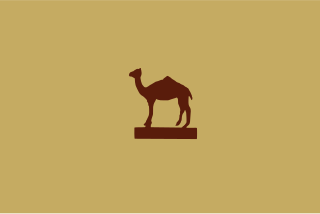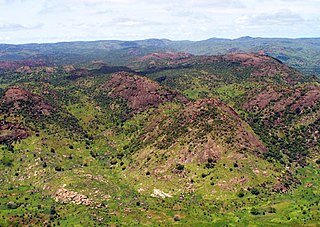Related Research Articles

Kordofan is a former province of central Sudan. In 1994 it was divided into three new federal states: North Kordofan, South Kordofan and West Kordofan. In August 2005, West Kordofan State was abolished and its territory divided between North and South Kordofan States, as part of the implementation of the Comprehensive Peace Agreement between the Government of Sudan and the Sudan People's Liberation Movement. West Kordofan was reestablished in July 2013.

The Nuba Mountains, also referred to as the Nuba Hills, is an area located in South Kordofan, Sudan. The area is home to a group of indigenous ethnic groups known collectively as the Nuba peoples. In the Middle Ages, the Nuba mountains had been part of the Nubian kingdom of Alodia. In the 18th century, they became home to the kingdom of Taqali that controlled the hills of the mountains until their defeat by Mahdi Muhammad Ahmad. After the British defeated the Mahdi army, Taqali was restored as a client state. Infiltration of the Messiria tribe of Baggara Arabs has been influential in modern conflicts. Up to 1.5 million people live in the mountains, mostly ethnic Nuba, with a small minority of Baggara.
The Nuba people are indigenous inhabitants of central Sudan. Nuba are various indigenous ethnic groups who inhabit the Nuba Mountains of South Kordofan state in Sudan, encompassing multiple distinct people that speak different languages which belong to at least two unrelated language families. Since 2011, when the southern part of Sudan became an independent state as South Sudan, the Nuba now live in the southern part of Sudan. Estimates of the Nuba population vary widely; the Sudanese government estimated that they numbered 2.07 million in 2003.
The Kadaru are a sub-ethnic group of the Nuba peoples in the Nuba Mountains of South Kordofan state, in southern Sudan. They live in the Kadaru Hills between Dilling and Delami in South Kurdufan.
Koalib Nuba is an ethnic group of the Nuba peoples in the Nuba Mountains of South Kordofan state, in southern Sudan. It numbers more than 150,000 persons.
The Krongo Nuba are a sub-ethnic group of the Nuba peoples in the Nuba Mountains of South Kordofan state, in southern Sudan. They number several 10,000 persons. This minority is divided in terms of religion.
Lafofa is an ethnic group among the Nuba people of Sudan. It likely numbers less than 10,000 persons. This minority is mainly Muslim. Many of them speak Arabic. The traditional language is Lafofa, a Niger–Congo language. They live in South Kurdufan.
The Logol are a sub-ethnic group of the Nuba peoples in the Nuba Mountains of South Kordofan state, in southern Sudan. Its population is estimated to be under 10,000.
The Otoro Nuba are an ethnic group in the Nuba Mountains of South Kordofan state, in southern Sudan.
The Tagale are a sub-ethnic group of the Nuba peoples in the Nuba Mountains of South Kordofan state, in southern Sudan.
The Talodi are a sub-ethnic group of the Nuba peoples in the Nuba Mountains of South Kordofan state, in southern Sudan. They likely number more than 1,000 people.
The Tima are an ethnic group of the Nuba Mountains in South Kordofan state, in southern Sudan. They number several thousands.
The Daju people are a group of seven distinct ethnicities speaking related languages living on both sides of the Chad-Sudan border and in the Nuba Mountains. Separated by distance and speaking different languages, at present, they generally have little cultural affinity to each other.
Usicayos District is one of ten districts of the Carabaya Province in Peru.
The Keiga people are a sub-ethnic group of the Nuba peoples in the Nuba Mountains of South Kordofan state, in southern Sudan. The population of this ethnicity likely is below 10,000. They speak Keiga, a Nilo-Saharan language. The language belongs to the Kadugli–Krongo family.
Krongo, also spelled Korongo or Kurungu and known as Dimodongo, Kadumodi, or Tabanya after local towns, is a Kadu language spoken in the South West of the Nuba Mountains in Kordofan. Fama is a dialect.
Afitti is a language spoken on the eastern side of Jebel el-Dair, a solitary rock formation in the North Kordofan province of Sudan. Although the term ‘Dinik’ can be used to designate the language regardless of cultural affiliation, people in the villages of the region readily recognize the terms ‘Ditti’ and ‘Afitti.’ There are approximately 4,000 speakers of the Afitti language and its closest linguistic neighbor is the Nyimang language, spoken west of Jebel el-Dair in the Nuba Mountains of the South Kordofan province of Sudan.
Wali is a Hill Nubian language spoken in the northwestern Nuba Mountains in the south of Sudan. It is spoken by around 9,000 people 12 km northeast of Katla. Ethnologue reports that use of Wali is vigorous and that there are many monolingual speakers. Young children speak English and Wali, but it is expected that the next generation will continue to communicate using Wali.
The Subori, are an ethnic group in the southern part of Sudan. They are one of seven distinct ethnicities comprising the Daju people. They speak the Subori language, a Nilo-Saharan language. They live in the north, central Nuba Mountains in the Jebel Subori hills area northeast of Kadugli. The population of this ethnic group likely exceeds 12,000.

The Nuba Mountains, located in the West Kordofan and South Kordofan states in the south of Sudan, are inhabited by a diverse set of populations speaking various languages not closely related to one another.